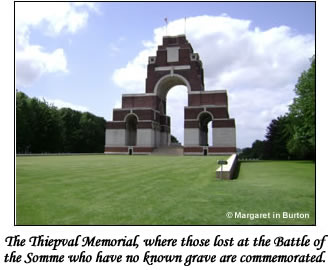The Battle of the Somme took place in Northern France. You can read more in depth about it here: The Somme.
The main reason for the battle was to relieve the French army who were suffering a severe German onslaught at Verdun.

The great majority of Empire troops were volunteers or conscripts and had no experience of war. Conscription had expanded the army enormously, but it also meant that its commanding officers had no experience of being in charge of huge numbers of men. For more information about recruitment go to Enlistment into the British Army 1914-1918.
The Battle itself stretched from its blood-soaked beginnings on 1st July 1916, to its mud soaked finale on 13th November 1916.
The last week in June was a week of heavy bombardment of the German lines, the British commanders believing that the enemy positions would be destroyed and Allied troops would simply walk over no mans land and occupy the shattered German trenches. Unfortunately the German trenches were deep and solidly made, so their occupants, in fact, suffered few casualties, as the bombardment made little impression.
That first battle on 1st July was officially called the Battle of Albert after the little town nearby. Over the following weeks and months there were a series of battles within the ‘Battle of the Somme’: Albert, Buzentin Ridge, Pozieres and Mouquet Farm, Guillemont-Ginchy, Flers-Courcellette (where the British secret weapon of the tank first appeared on a battlefield), Morval, Thiepval Ridge, Le Transloy, Ancre Heights and finally Ancre itself. Even though for most people it is 1st July 1916 which represents the Battle of the Somme.
In talking about the battle, in particular 1st July, it is necessary to talk about the generals. The members of the excellent Great War Forum have very kindly given me a great deal of help and information, in order that I can offer a balanced view.
Their suggestions included these books:
‘Haigs Generals‘ edited by Ian F.W. Beckett and Steven J Corvji, which includes Generals Allenby, Birdwood, Byng, Gough, Horne, Monro, Plumer, Rawlinson and Smith Dorien
‘The Donkeys: A History of the British Expeditionary Force in 1915‘ by Alan Clark
‘War Diaries and Letters 1914-1918‘ by Gary Sheffield and John Bourne
‘Douglas Haig: The Educated Soldier‘ by John Terraine
‘The Good Soldier: The Biography of Douglas Haig‘ by Gary Mead
‘Haig: A Re-appraisal 70 Years on‘ by Brian Bond and Nigel Cave
‘Douglas Haig as I knew him‘ by George Simpson Duncan.
All of these publications are available to purchase on the Amazon website.

The debate section of the World War One pages on the BBC website was also suggested. One respondent said that, “There were certainly better generals, but perhaps not commander in chiefs”. Another said, “I like Haig. Haig and his armies won the most significant victory by any British Army. There was simply no-one else capable. As Pershing said in the early thirties, “It was Haig and his Army that won World War One”. Knocking our heroes is something only the British do”.
As has been mentioned, the Allies bombarded the German lines for a week, and on the day of the attack 17 mines were blown, the most famous being Hawthorn Crater, which was the first one to be blown at 7.20am and filmed. You can view it on YouTube – Mine Explosion.
Also, you can see a famous piece of film on YouTube – Sunken Lane showing men of the Lancashire Fusiliers, sheltering on the enemy side of the lane just before going over the top. Most of them didn’t see the day out.
There are many more fascinating films of the Battle of the Somme on the You Tube website, which will be listed under ‘related videos’ once you use these links to enter the site. In particular this film, YouTube – Battle of the Somme – Real Footage, will give you an idea of what conditions were like for the soldiers.
Eleven British Divisions walked over the top into no man’s land, most of them heavily laden with equipment. Although a few units reached their objective, they could not hold them and were driven back. By the end of the day there were nearly 60,000 Allied casualties and almost 20,000 dead.
Amongst them the 1st Newfoundland Regiment from Canada; of the 801 men who went over the top at 8.45am, 733 were killed or wounded within just half an hour.
And still the battle had a very long way to go…
Just Barbara
© Just Barbara 2008
SOURCES
The Long, Long Trail: The Lancashire Fusiliers
HistoryofWar: The Battle of Albert
FURTHER READING
CWGC: The Battle of the Somme
The Long, Long Trail: The Battles of the Somme
Imperial War Museum: The Battle of the Somme